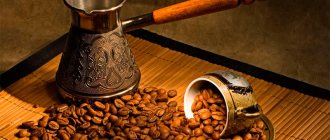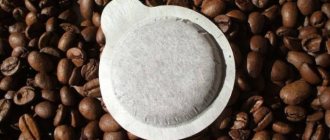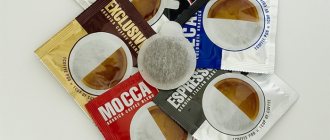Cappuccino originated in Italy. Monks from the Capuchin Order invented an original method of making coffee. Using cold and warm, and then hot milk, they changed the taste of the drink. Followers began experimenting to find out which milk is better for cappuccino - animal or vegetable origin, full-fat or low-fat, whether it can be replaced with cream and how to whip the foam correctly.
General idea of cappuccino
Cappuccino was invented hundreds of years ago by Italian Capuchin monks. The drink consisted of coffee and milk with high fat content, at that time goat milk was used for preparation. Today there are many recipes known that make it possible to obtain such coffee; an integral component of each of them is milk whipped to a thick foam.
The classic cappuccino recipe involves strong espresso, frothed milk and thick milk foam.
Also, other ingredients are added to the drink that significantly affect its taste: chocolate, all kinds of syrups, etc. As a rule, the composition of cappuccino varies depending on the location of preparation. At first, the drink was whipped by hand, and then a special device (cappuccino maker) was invented, consisting of two containers: for milk and water. The steam generated by heating the water flowed through a tube into a container with milk, whipping the product into a thick foam. Modern coffee machines whip up steam on their own.
Lactose intolerance: where to get milk for cappuccino and latte?
Some people, due to their physiological characteristics or religious reasons, cannot use animal milk. How, then, can you prepare a delicious coffee drink in a coffee machine with subtle milky notes? Experts recommend using plant analogues of milk, with which coffee reveals its taste in a new way.
Most often used:
- Almond milk - when whipped separately, this milk separates and curdles, so experts use a trick. First, espresso is prepared, then almond milk is added and the whole thing is whipped in a cappuccino maker.
- Oat milk - milk whips well, has a dense consistency, but the foam is unstable and in the next 3-5 minutes it settles by half.
- Soy - easily whips into foam, but does not tolerate high temperatures, so it is added to slightly cooled ready-made coffee.
Expert opinion
Borodina Galina Valerievna
Experts ask you to pay attention to the fact that milk of the same brand can froth differently and have an uncharacteristic taste. It all depends on the raw materials used and the characteristics of production.
Milk fat content value
The level of fat content determines not only the taste of the drink, but also its consistency. The optimal indicator for making cappuccino is 3–4%. This milk can be called the golden mean: it is not watery, but not too fatty, which makes it possible to achieve the ideal combination of taste and density of coffee. It also produces a signature foam: sweetish-creamy and thick, for which cappuccino is valued.
A drink made from milk with a low fat content (1–2%) does not differ much in taste from its counterpart with a fat content of 3.5%. However, this coffee seems too liquid. Sometimes the barista mixes milk (3.5%) with skim milk. This decision is absolutely wrong, and the difference is clearly visible.
When using milk with low fat content, a dry and fairly dense foam is obtained, which gives the coffee a gray tint, but does not make its consistency thicker.
You can get a fragrant and rich cappuccino only with the addition of milk of 3–3.5% fat.
The best brands of milk for cappuccino in the mid-price segment
Petmol UHT 3.2% “For cappuccino”
The ultra-pasteurized product is popular and in demand among coffee lovers. The foam stays high and fluffy for a long time, since the composition contains a high amount of proteins - 3.7%. But due to the low fat content (3.2%), the drink lacks the familiar creamy-sweet taste. However, cow's milk is actively used for the preparation of fancy drinks, it is recommended as the “choice of professionals” due to its good whipping and excellent foam.
Packed in a cardboard bag with protective foil, has a dispenser.
Volume - 0.95 l.
Cost: 88 rubles.
Petmol UHT milk 3.2% “For cappuccino”
Advantages:
- beats perfectly;
- the foam is dense and lasts a long time;
- The drink is soft and delicate.
Flaws:
- not sold everywhere;
- volume less than 1 liter.
Milk river “For cappuccino”
Ultra-pasteurized premium milk 3.5% fat, can be purchased in a package consisting of 12 packages. Production is made from natural raw materials based on new technologies, thanks to which the product retains all useful vitamins and microelements.
The milk is whipped into a thick, fluffy foam, the drink acquires a creamy, nutty, unforgettable taste thanks to the optimal amount of protein (2.8 g) and fat (3.5 g). This ratio allows even a hand whisk to achieve an airy, sweetish foam.
Packed in a tetra pack with protective foil and a plastic ring.
Volume - 0.973 l.
The cost of a pack is 1080 rubles, 1 package is 90 rubles.
milk Milk river “For cappuccino”
Advantages:
- excellent taste;
- lush foam;
- easy to whip;
- long shelf life;
- dense packaging with a slanted top and an HDPE lid.
Flaws:
- difficult to find on sale.
Lactose and protein content
The amount of protein contained in the drink affects the quality characteristics of the foam:
- gives stability that allows it not to settle for a long time;
- makes the creamy taste more pronounced;
- imparts elasticity.
For you:
Cupping coffee - what is it?
This effect can be achieved provided that milk containing at least 3 g of protein is used to prepare cappuccino.
For cappuccino, only natural products are chosen, excluding the presence of various powders.
The classic sweet taste of the foam is provided by milk sugar (lactose). When heated, it splits into two components: galactose and glucose. It is possible to get a “cap” with a rich taste only if the carbohydrate content is not lower than 4 g. Due to lactose intolerance by some people, good coffee shops prepare lactose-free cappuccino with a top that is not inferior in taste to the classic version.
Methods for processing milk for frothing
If you are preparing cappuccino in an automatic coffee machine, the milk must first be cooled to a temperature of 3-6 degrees Celsius and poured into the coffee machine in this form.
When whipping milk manually or whipping it with a special apparatus (pitcher), you must first make a light foam on a cold product (temperature below 37 degrees). Then the milk is heated to 65-70 degrees in a steam bath and whipped. It is at this temperature that it is easiest to achieve persistent foam and the appearance of sweetness. If the degrees are higher, the sweetness will disappear.
Under no circumstances should milk intended for cappuccino be boiled. This way you will “kill” its structure and properties, and there will be no chance to beat it.
Suitable milk temperature
The rules for preparing high-quality cappuccino require the use of milk at a temperature of +4 °C. In addition, the product should not be boiled before beating. In the process of obtaining foam, it is important not to exceed the temperature, varying in the range: +67… +75 °C. Otherwise, protein compounds will be destroyed, the drink will acquire an unpleasant odor and bitter taste, and the foam will not meet the stated characteristics.
Milk is whipped only in a dry pitcher, since contact of this product with moisture significantly impairs the frothing process.
Making a delicious cappuccino
To prepare a flavorful drink, you need to properly prepare the base. It requires quality coffee. If you have a coffee machine, the preparation process is simplified. If it is not there, the base of the drink can be brewed in a regular pot:
- Pour the required amount of coffee into the pot.
- Fill it with warm water, put it on the stove and bring to a boil.
- We make sure that the coffee does not boil; when the foam rises, immediately remove the drink from the heat.
- After the coffee foam settles, the procedure must be repeated three times to ensure the coffee is strong and aromatic.
- Pour the drink into a ceramic container.
- Froth the milk in a cappuccino maker until you get a fluffy foam.
- Using a spoon, carefully place it on the surface of the coffee drink.
The proportions of the ingredients must be equal. There is no need to mix them.
Having learned how to quickly whip milk into foam, you can prepare a tasty and healthy cappuccino drink for yourself and your loved ones.
Let's consider the rating of the best brands of milk for cappuccino, which, according to customers, enjoy trust and high purchasing power.
Characteristics of the right foam
The following signs indicate the quality of cappuccino foam:
- Uniform consistency, presence of bubbles. High-quality foam flows slowly from the spoon, and its height is maintained for a long time.
- The presence of a pronounced ice cream flavor , which can be achieved only from milk with the required fat content.
- Stickiness , which gives the drink a subtle taste and depends on the amount of protein contained in the product.
Also, the quality of foam is determined by such indicators as:
- chilled – colder milk whips faster and produces a stable foam;
- functionality of the device used for whipping; Over time, they become clogged and lose their original effectiveness.
Adding cream to milk, where the tradition comes from
The monks who invented this drink were far from stupid people and came up with the idea of adding a bit of heavenly pleasure in the form of thick cream to the devilish black coffee. Afterwards, they put the drink on the fire, the cream spread in a thick mass over the surface of the coffee, and when stirred, an aromatic and creamy taste was obtained that did not lose its strength.
Today, in coffee establishments, cream is added to milk in order to bring the drink as close as possible to the original, on the one hand, and to preserve the soft, uniform foam that coffee lovers love so much, on the other.
Which cream is best for cappuccino?
If you want a richer, creamier flavor, choose cream with no more than 10 percent fat content. If the fat content is more than ten, the cream will whip into stable peaks and when it comes into contact with hot coffee, lumps may remain on the surface of the drink.
In order to change the serving of the usual drink, you can whip 30% cream into a stable and strong foam and use a pastry bag to pipe a fluffy cap, if desired, decorate with chocolate shavings or other decor.
It is advisable to serve in tall glasses with a cocktail spoon.
Tips for choosing milk
When choosing, it is worth remembering that whole or natural fresh milk is not suitable for coffee machines, since their use significantly slows down the whipping process. Cappuccino is prepared from a pasteurized or ultra-pasteurized product, since it whips easily and allows long-term storage at room temperature without losing its original qualities.
It is best to give preference to milk with a special mark on the packaging - for example, “for cappuccino”, “for coffee machines” or “for whipping”. Using these options guarantees high quality foam.
Correctly selected products are simultaneously suitable for all types of devices: cappuccino maker, frother and paranello.
Cappuccino makers
Modern technologies allow you to freely prepare your favorite food in an ordinary home kitchen using special appliances. Coffee lovers can prepare any aromatic drink using cappuccino makers. With such devices, getting a cup of espresso, moccacino, latte, cappuccino and other types of coffee drinks does not take much time at home. All drinks have a pleasant appearance and magical taste.
Retail chains offer a large selection of various devices adapted to release steam, which helps froth milk for different types of coffee. Typically, cappuccino makers are sold complete with coffee machines, but can also be purchased separately. Their use provides advantages when preparing coffee due to attachments that greatly simplify the work:
- the milk is whipped and heated at the same time;
- preparation does not take a long time;
- light foam is obtained quickly and easily.
Milk frothers allow you to achieve excellent foam quality; the preparation process is fully automated: you need to add milk to the bowl and start the machine.
Based on their design, they are divided into groups of manual and automatic products.
Manual
The hand-held product is controlled directly by the user. The device contains a whisk - a spring and a bowl for liquid. This is a fairly common type of cappuccino maker; the device is portable, compact, and inexpensive. It is simple for frothing milk and making foam:
- the device promotes the formation of water vapor, which, using pressure, enters a specialized tube;
- froths milk, saturating it with air;
- the steam supply control function is installed;
- For each type of drink, the preparation of foam is simplified.
This type of beater is suitable for experienced coffee lovers. For beginners it will be difficult; the beating process must be controlled by a person. Without the skill, it is impossible to prepare a delicious cappuccino with fluffy foam.
Automatic
To make coffee in these devices, just press one button and the drink will be prepared. The user must only ensure that the food compartments are not empty and wash the device after the cooking process.
Each device has its own characteristics and differences. Therefore, before purchasing a coffee machine, you need to familiarize yourself in detail with its functions in order to make the right purchase - purchase a product for professionals or for beginners.
Panarello
The coffee machine comes with a small cylindrical nozzle for frothing milk, which is lowered into a bowl of milk liquid.
The Panarello attachment is used to make milk froth, it is often called a mechanical cappuccino maker, although in fact it is more of a manual device than a mechanical one. Its action is to supply streams of steam into the inside of the bowl of milk, where a lush, stable foam is formed, evenly distributed by air bubbles. Experienced baristas obtain foam without special attachments, but when the user wants to prepare the same coffee at home, manual cappuccino makers come to his aid.
The Panarello nozzle has a tube with holes made of stainless steel, the tip of which is connected to a device for supplying steam generated in a specialized boiler of the coffee machine.
Review of the best brands
Regardless of which device will be used to prepare cappuccino, it is important to choose milk that meets all the criteria. Professional baristas have identified several brands of this product, which, in their opinion, are considered the best for preparation:
- Rioba (3.5%, UHT). This brand's milk is prepared from normalized cow's milk and is considered an ideal option for making cappuccino coffee. The product whips well, does not require boiling, has a sweetish taste and forms a dense, stable foam.
- “Petmol” (3.2%, UHT). Made from natural ingredients, it has a natural taste. Milk of this brand allows you to achieve high-quality foam with a rich taste, even with a hand blender.
- “House in the Village” (3.2%, UHT, for cappuccino). The product has a bright taste and does not contain additives or preservatives. Thanks to the high protein content, the foam is thick and airy.
- “Molochnaya Rechka” (3.5%, UHT, for cappuccino). Made from natural milk, it whips easily into a dense, airy, stable foam with the taste of ice cream.
- “Prostokvashino” (3.5–4.5%, pasteurized or selected). It is characterized by high taste and quickly whips to the required consistency.
For you:
The best varieties of Turkish coffee beans
Why is milk added?
Cappuccino is made using espresso. This coffee has a bitter taste due to caffeine and tannin.
30 milliliters of espresso contains up to 75 milligrams of caffeine and 2% tannin. Find out more in the article “Espresso Coffee: What It Really Is.”
Expert opinion
Vadim Kudryavtsev
Coffee expert, professional barista and simply in love with this aromatic drink.
Ask the barista a question
Milk softens the bitter taste and prevents blood vessels from constricting, so the drink does not increase blood pressure.
Milk contains B vitamins and calcium, which are washed away by caffeine. It also contains protein, vitamin A, milk fat, phosphorus, potassium, and ascorbic acid.
Features of using plant milk and cream
To make cappuccino, it is permissible to use a plant product made from coconut, soy, cereals, almonds, rice and nuts. However, when choosing them, it is important to consider a number of nuances:
- Milk of plant origin does not allow you to get foam with sufficient thickness.
- The nut, coconut and almond product is characterized by a high calorie content (up to 150 kcal per 100 g), therefore, when whipped, it forms a fluffy foam.
- The calorie content of milk made from cereals and soy is 50 kcal per 100 g, so the foam is less fluffy.
When using plant milk, coffee loses its creamy flavor and thick consistency.
Some baristas prefer to make cappuccino from cream: its rich taste gives the drink new shades. To get the right coffee, it is recommended to choose cream with a fat content of 10–15%. In this case, the foam will be uniform, smooth and with a pleasant texture. A product with a higher indicator, when whipped, forms lumps that are unpleasant in taste and unattractive in appearance.
Cappuccino is one of the most popular drinks prepared in bars, restaurants and at home. To obtain the appropriate quality, it is important to use milk with suitable characteristics.
Cooking rules
Which milk is best for cappuccino in a coffee machine?
The coffee machine simplifies the preparation of a coffee drink. A coffee maker is also a good choice if it has a built-in cappuccino maker.
Delonghi's company has proven itself to be a good company. It produces capsule coffee machines, coffee makers and automatic coffee machines.
Subtleties and nuances
To properly froth milk for cappuccino in a coffee machine, follow these rules.
Before frothing liquid, clean and dry the cappuccino maker so that no condensation or dirt remains inside.
Choose a separate mug of 250-200 milliliters (for 100-150 milliliters of milk). The drink is whipped for 15-25 seconds. During this time, the liquid level doubles.
Place the mug under the cappuccino maker when the steam becomes dry, without liquid. Do not place the tube perpendicularly. It is important that a 45-degree angle is formed so that the tube whips the foam correctly. The nozzle should not reach the bottom of the mug; there should be 0.7 centimeters between them.
When the foam rises and rises close to the edge, you need to lower the nozzle deeper down, slowly and smoothly moving the mug from side to side.
Find out more in the article “How to froth milk for cappuccino.”
How to add foam to coffee
If frothing milk for cappuccino has been done correctly, pouring the foam into the cup will be easy. However, you will need to take into account the nuances. Methods:
- Holding the foam with a spoon, carefully pour the milk into the cup, pour in the coffee, and only then transfer the foam so that it is held on the surface of the coffee with milk.
- First pour milk with foam into a cup, and then carefully pour coffee in a thin stream along the wall.
Rules for serving cappuccino:
- Demitasse cup with a volume of 150–180 ml made of thick-walled ceramics.
- The cup is preheated (on the boiler of a coffee machine or by pouring boiling water over it).
- Drink temperature 60–65 °C.
If these conditions are met, the drink will not cool down, and the foam will not lose density due to temperature changes.
How to replace natural milk
Today, you can increasingly meet people who refuse to drink natural milk in favor of alternative plant milk. Some do this for health reasons (lactose intolerance), others for ethical reasons. There are also those who simply follow fashionable trends in vegetarianism.
For such cases, manufacturers have provided coconut, almond, and soy milk. But it must be said right away that its composition is radically different from natural cow’s milk. For example, there is much less important protein than required. Therefore, when heated and foamed, the product “behaves” completely differently. The whipped top turns out loose, with large bubbles, and settles quickly. It often flakes off from the milk itself, and it tastes “fresh.”
Attention! In order to somehow compensate for these shortcomings, thickeners (carrageenan), artificial sweeteners, and stabilizers (guar gum) began to be added to plant milk. Therefore, before purchasing such a product, carefully study its composition. After all, the same carrageenan (a polysaccharide from red seaweed) provokes gastrointestinal diseases and causes intestinal inflammation.
The plant composition of the product affects not only the taste characteristics, the height of the top, but also the design of the prepared drink. It is animal proteins that provide a beautiful pattern on cappuccino foam. And the coffee machines themselves are designed to use cow's milk, not plant milk.
What kind of milk is suitable for creating foam?
There are several important characteristics to consider. Then the foam will retain its elasticity and will not settle.
Fat percentage
The minimum indicator is 3%. This determines what consistency the finished dish will have. The maximum you can take is up to 6%. But if the fat content is too high, it will clog the taste buds, and there is a high probability that the taste of the coffee itself will not be felt. The more intense the taste of the grain, the fattier the milk you can take.
Finding the right ratio takes some time. 3.2-4% milk fat content is considered the optimal level for coffee shops. Cappuccino without foam is prepared according to a slightly different scheme.
Protein content
Milk contains up to 20% whey protein and 80% casein. When heated, these components behave differently, their structure differs from each other. In terms of thermal stability, casein is superior to whey protein. It is able to maintain structure under different conditions.
In whey protein it is characterized by higher complexity and three-dimensionality. When this substance is cold, it is like a ball; when heated, it seems to unfold into a chain shape. This is a process called denaturation.
In most cases, the protein content does not exceed 3-3.3%. More of this element is always added to commercial products. Then the foam will be stable and durable.
Milk temperature
Heat milk using a microwave or on the stove. 70-75°C is the optimal temperature. The main thing is to make sure that steam does not form.
For a microwave oven, it is better to choose a power of 600W; it is maintained for 1 minute.
How milk and coffee met
Until the 17th century, most Europeans, not counting travelers and merchants who traded with the East, did not know the taste of coffee. When the first coffee shops finally began to open in European capitals, the local population did not immediately fall in love with the drink: its bitterness was too unusual, and the appearance of the dark brown liquid seemed unappetizing to many.
Indulging the tastes of visitors, innkeepers began to look for a way to mask the bitter taste. In those days, even the rich were not overly spoiled by sweets: sugar brought from the colonies was very expensive, honey was also not cheap. Accordingly, if a sweetener was added to the already expensive coffee, the price of the drink increased, and the number of people willing to try the overseas wonder decreased.
In different European countries, independently of each other, coffee shop owners came up with the idea of softening coffee bitterness with milk. The French, Austrians, and Italians take the lead. Perhaps the latter are right: most coffee drinks have Italian names.
When milk began to be added to coffee everywhere, healthy competition began among baristas: milk was whipped in a variety of ways, achieving the most homogeneous foam, simmered in the oven until brown, experimented with fat content and temperature, painted with milk foam on the surface of the coffee - in a word, they did everything to attract visitors. In the 20th century, the practice was supported by scientific theory, thanks to which the art of frothing milk reached unprecedented heights.
Milk not only changes the taste of coffee, but can also serve an aesthetic function
Why choose ultra-pasteurization and what is it?
There is an important rule - milk for cappuccino cannot be boiled. The fact is that not only the concentration of proteins, fats, carbohydrates ensures good foaming, but also a certain temperature of the product. According to baristas, milk should be heated to 60-68 °C. It becomes sweetish and creamy, which is important for foam.
Starting from +70 °C, protein destruction occurs, texture, shade and even taste change. The listed nuances do not allow you to properly whip the foam and provide the necessary sweetness and creamy taste to the airy “cap”.
For the reason stated above, milk for cappuccino is not boiled, but is ultra-pasteurized:
- the natural farm product is heated to 140 °C in special sealed containers;
- hold for 4 seconds;
- cool instantly;
- poured into Tetra Fino Aseptic tetra packs.
During this processing, no chemicals (preservatives) or antibiotics are used. The product itself is removed from bacteria in a safe, technologically proven way, retaining its taste and beneficial microelements. The inner surface of its packaging is aseptic. If sealed, the closed package allows storage for up to 60 days. After opening, the milk is stored as pasteurized.











